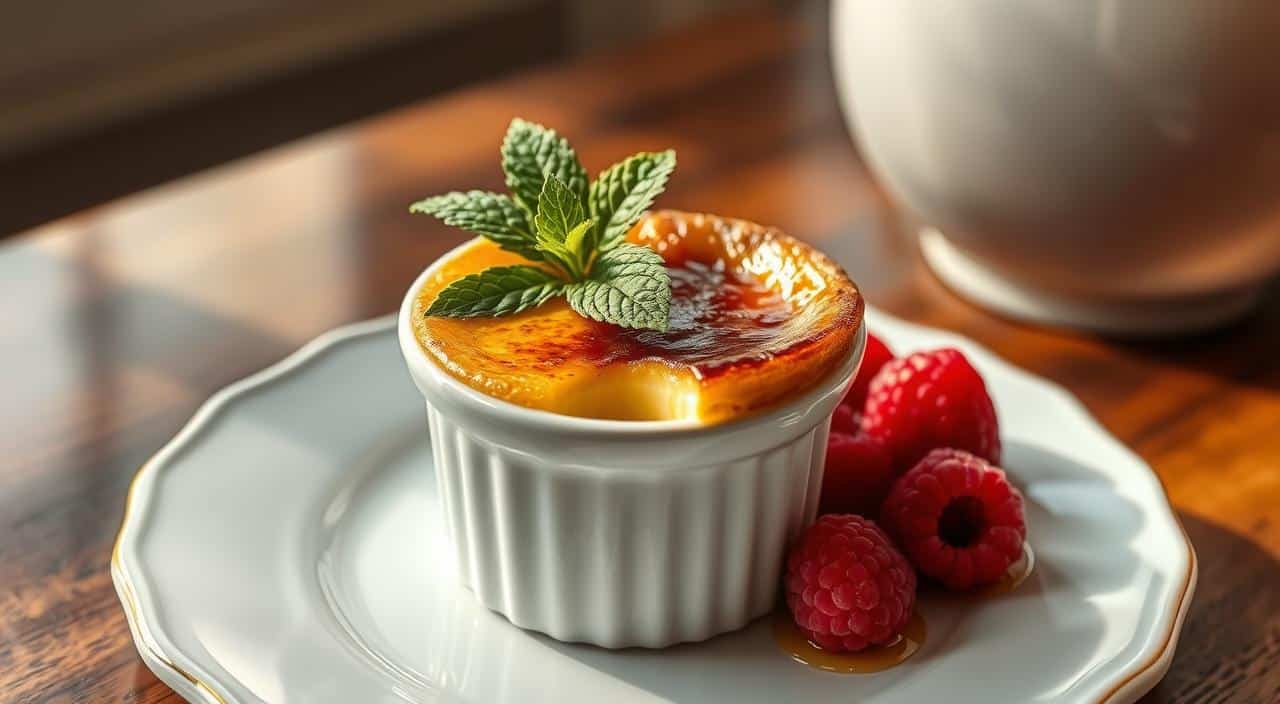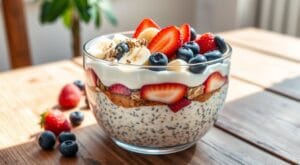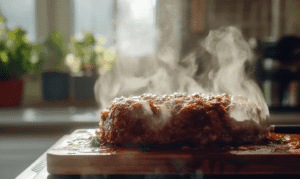Jump to:
Estimated reading time: 16 minutes
Table of contents
How to caramelize sugar on brulee? Crème brûlée is a French dessert loved by many. Its charm comes from the caramelized sugar on top, contrasting with the creamy custard below. Learning to caramelize sugar on brûlée is a skill many want to master. With the right tools and techniques, you can get that perfect golden finish at home.
This guide will cover the science of caramelizing sugar and the tools you need. We’ll also show you how to make your crème brûlée a hit every time. Whether you’re a pro chef or a home cook looking to improve, this article will help you make a memorable crème brûlée.
How to caramelize sugar on brulee? Key Takeaways
- Discover the secrets to perfectly caramelizing sugar on crème brûlée
- Learn expert techniques, tools, and tips for achieving that irresistible crispy top layer
- Understand the science behind caramelization and how to achieve even heat distribution
- Explore the best kitchen torch options and alternative tools for caramelizing sugar
- Mastering the step-by-step process to ensure a consistently flawless brûlée top
Introduction
How to caramelize sugar on brulee? Crème brûlée is a classic French dessert known for its rich custard and caramelized sugar topping. It’s a favorite in fancy restaurants but can be made at home for less. With the right tools and techniques, you can make a crème brûlée that wows your guests.
The secret to a great crème brûlée is the caramelized sugar on top. Learning how to caramelize sugar creates a crunchy layer that breaks easily, showing off the creamy custard underneath. You can use a kitchen torch or oven broiler to get it just right.
In this guide, we’ll explore how to caramelize sugar on crème brûlée. We’ll cover the tools and ingredients you need, the step-by-step process, and common mistakes to avoid. Get ready to become a pro at making crème brûlée and impress everyone with your skills.
Crème brûlée recipe is a great place to start learning about caramelizing sugar on this classic dessert.
Understanding the Science Behind Caramelizing Sugar on Brûlée
Caramelizing sugar is a fascinating art in cooking. When sugar heats up, its molecules change, creating new compounds. This leads to the golden color and rich flavors of caramel. Knowing this process helps make the perfect caramelized top on crème brûlée.
How Sugar Reacts to Heat
Heating sugar causes its crystals to melt and change. The heat removes water from the sugar molecules. They then form new structures through a process called caramelization.
This process creates many flavor compounds. These include furaneol, maltol, and hydroxymethylfurfural. They give caramel its unique taste and smell.
Different Types of Sugar for Caramelization
- Granulated sugar, also known as caster sugar, is the most used for caramelizing crème brûlée. Its small crystals melt evenly, making a smooth, golden crust.
- Brown sugar, with more moisture and complex flavors, can also be used. It might give a different texture and taste.
- Specialty sugars, like vanilla or citrus flavors, can add unique twists to the caramelized topping. They enhance the overall experience.
The Importance of Even Heat Distribution
Getting the perfect caramelized sugar top on crème brûlée needs careful heat control. Uneven heat can cause spotty caramelization. This results in a less-than-ideal texture and look.
It’s important to ensure the sugar layer gets consistent, gentle heat. This is key for a uniform, shiny crust that shatters beautifully with each bite.
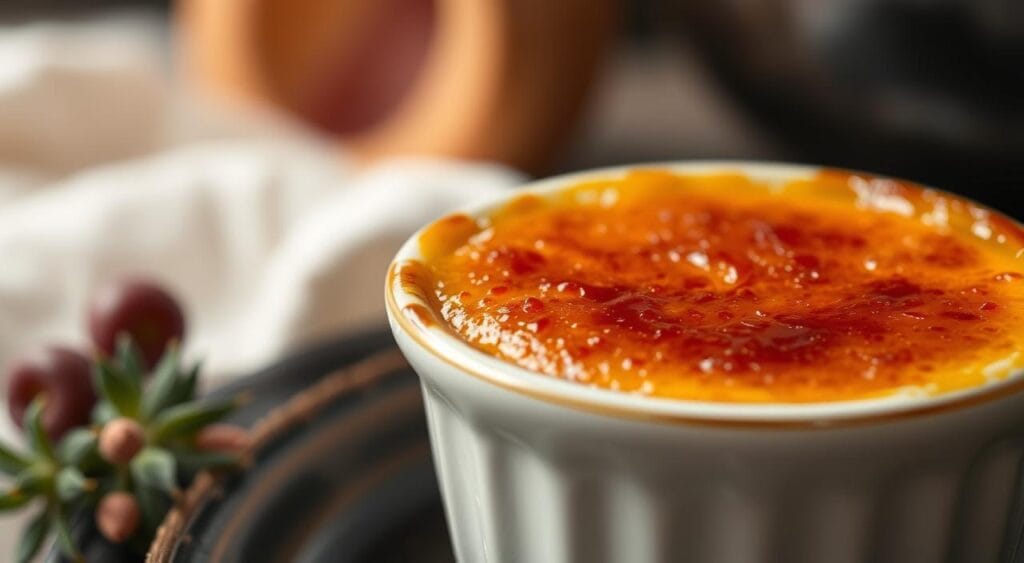
“The key to mastering crème brûlée is understanding the science behind caramelizing sugar. With the right techniques and a keen eye for detail, you can transform a simple dessert into a true work of culinary art.”
Tools You Need to Caramelize Sugar on Brûlée
To make the perfect caramelized topping on crème brûlée, you need the right tools. The key tool is the kitchen torch. It’s a small, handheld burner that gives intense heat to melt and caramelize sugar quickly.
How to caramelize sugar on brulee? Choosing the Best Kitchen Torch
A good kitchen torch is a great investment for home cooks. These tools are affordable and easy to find. They help you get even caramelization on your custard.
How to caramelize sugar on brulee? Alternative Tools: Broiler vs. Torch
Some people use a broiler instead of a kitchen torch. But, broilers can be hard to control. They often cause uneven caramelization. A kitchen torch, on the other hand, gives you precise heat for a perfect golden-brown crust.
How to caramelize sugar on brulee? The Perfect Dish for Crème Brûlée
The best dish for crème brûlée is a shallow, round ramekin. It should be 4 to 5 inches in diameter. This size cooks the custard evenly and balances the silky interior with the crispy topping.
| Caramelizing Tool | Pros | Cons |
|---|---|---|
| Kitchen Torch |
|
|
| Broiler |
|
|
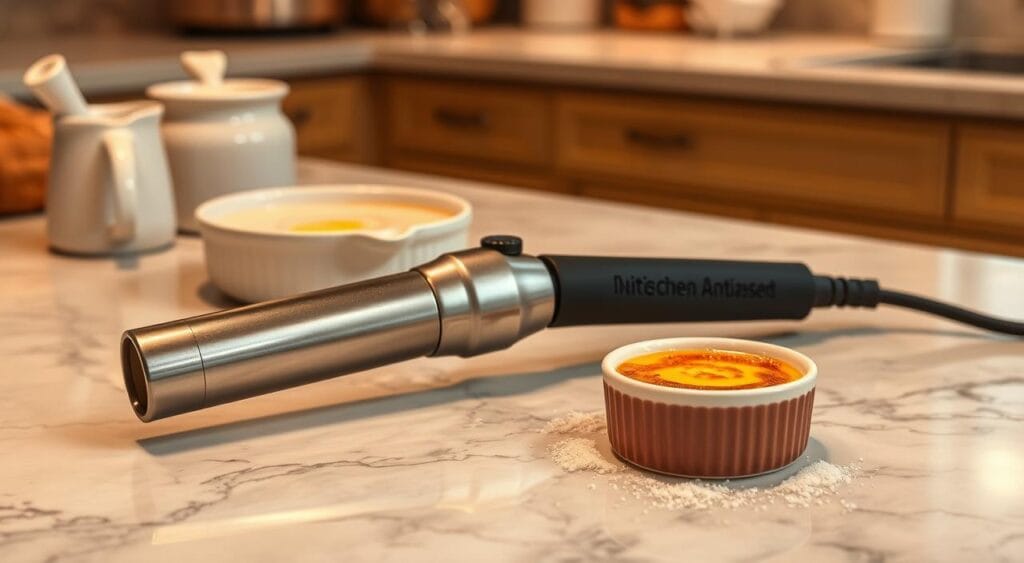
“A kitchen torch is the gold standard for caramelizing sugar on crème brûlée, providing the perfect balance of control and speed for achieving a crisp, golden-brown crust.”
Preparing the Sugar for Caramelization
To get the perfect caramelized topping on crème brûlée, you need the right sugar. White granulated or caster sugar works best. They caramelize evenly, creating a crisp, golden crust.
How to caramelize sugar on brulee? Choosing the Right Sugar Type
While you can try other sugars, white granulated sugar is the safest choice. It caramelizes well, making a thin, even layer that breaks beautifully with each bite.
How to caramelize sugar on brulee? How Much Sugar to Use for the Top
For the caramelized topping, use about 1-2 teaspoons of sugar per serving. This amount creates a thin, even layer that caramelizes perfectly without overpowering the custard.
How to caramelize sugar on brulee? Ensuring Even Coverage of the Sugar Layer
It’s important to spread the sugar evenly over the custard for a consistent caramelized finish. Sprinkle the sugar in a thin, even layer, covering the whole surface. This way, you get a beautifully caramelized top with no bare spots.
| Sugar Type | Amount for Crème Brûlée | Caramelization Characteristics |
|---|---|---|
| White Granulated Sugar | 1-2 tsp per serving | Evenly caramelizes to a crisp, golden crust |
| Caster Sugar | 1-2 tsp per serving | Caramelizes quickly to a smooth, shiny finish |
| Brown Sugar | 1 tsp per serving | Caramelizes to a deeper, richer color with a complex flavor |
By choosing the right sugar and spreading it evenly, you can get a caramelized topping that enhances the creamy richness of the crème brûlée.
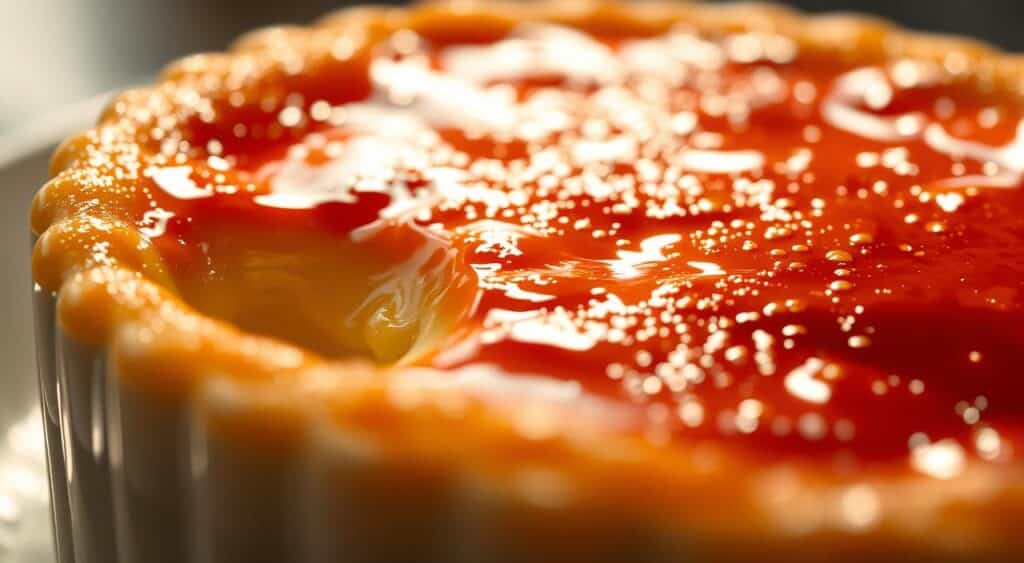
Step-by-Step Process to Caramelize Sugar on Brûlée
Making the perfect crème brûlée with a golden-brown sugar topping is a fun process. It needs careful attention to detail. Let’s explore how to caramelize sugar on this classic French dessert.
Step 1: Preparing the Custard Base
The base of crème brûlée is a creamy custard. Start by making the custard base as your recipe suggests. This involves heating heavy cream, milk, and vanilla bean gently. Then, mix in egg yolks and sugar carefully.
Once the custard is ready, bake it in ramekins until it’s just set. This takes about 30-40 minutes at 325°F (165°C). Let the custards cool completely before moving on.
Step 2: Sprinkling the Sugar Evenly
After the custards cool, it’s time to add the sugar topping. Sprinkle a thin layer of granulated sugar, about 50 grams per 4 servings, over the custards. Make sure to spread the sugar evenly across the top.
Step 3: Torch Technique for Even Caramelization
Now, it’s time to caramelize the sugar. Use a kitchen torch to melt the sugar. Hold the flame 2-3 inches away from the custard and move it in circles. Start at the edges and work your way inwards.
Keep the flame moving to ensure even caramelization. This prevents burning or thickening in any area. Work quickly and steadily to get a crisp, golden-brown crust.
By following these steps, you’ll master caramelizing sugar on crème brûlée. You’ll enjoy a delightful contrast between the creamy custard and the crisp, caramelized topping.
Common Mistakes to Avoid When Caramelizing Sugar on Brûlée
Making the perfect crème brûlée means mastering caramelizing the sugar on top. There are a few common mistakes that can ruin your dessert. Knowing these mistakes helps you get a perfect, golden crust every time.
Burning the Sugar Too Quickly
Burning the sugar too fast is a big problem. It makes the crust bitter and charred, ruining the dessert’s taste. Use a kitchen torch and move it constantly. Keep it at an even distance from the sugar to avoid burning.
Uneven Caramelization or Crystallization
Uneven caramelization or sugar crystals can also mess up your brûlée. It makes the topping uneven, with some parts crisp and others dull. To fix this, spread the sugar evenly and use a steady torch.
Using the Wrong Sugar Type
The sugar you choose affects caramelization. Sticky sugars like brown sugar are hard to work with. They often caramelize unevenly or form crystals. For the best results, use high-quality white granulated sugar when caramelizing sugar on crème brûlée.
| Mistake | Cause | Solution |
|---|---|---|
| Burning the sugar too quickly | Holding the torch too close or applying too much heat | Keep the torch moving constantly and maintain an even distance from the sugar |
| Uneven caramelization or crystallization | Inconsistent sugar distribution or torch application | Ensure even sugar coverage and use a controlled, consistent torch technique |
| Using the wrong sugar type | Sticky or moist sugars like brown sugar caramelize unevenly | Opt for high-quality white granulated sugar for the best results |
“The perfect crème brûlée is all about balance – a creamy, silky custard base topped with a crisp, golden-brown caramelized sugar crust.”
How to Achieve a Thick or Thin Brûlée Top
The thickness of the caramelized sugar topping on crème brûlée is up to you. A thicker layer gives a crunchy crust, while a thinner layer is delicate and crisp. The heat and movement of the torch affect the caramel’s thickness.
Adjusting Sugar Thickness for Personal Preference
- For a thicker, crunchier brûlée top, use a generous tablespoon of sugar per serving.
- For a thinner, more delicate crust, use a light sprinkling of around 1-2 teaspoons of sugar per serving.
- Experiment with the sugar amount to find your ideal thickness and texture.
Controlling Torch Heat for Desired Thickness
The intensity and movement of the kitchen torch also play a role in achieving the desired caramelized layer:
- Hold the torch further away from the sugar for a slower, more even caramelization and a thicker crust.
- Move the torch quickly and closely over the sugar for a thinner, more delicate caramelized top.
- Adjust the torch’s heat setting to control the caramelization speed and thickness.
How to Fix Overly Thin or Thick Caramel Layers
If the caramel layer ends up too thin or too thick, there are a few techniques to fix it:
- For a thin crust, re-sprinkle a light layer of sugar over the top and briefly re-caramelize with the torch.
- To reduce an overly thick caramel layer, use a spoon to gently crack the crust and expose the custard underneath.
“The thickness of the caramelized sugar topping is a crucial element that can make or break the perfect crème brûlée experience.”
Can You Caramelize Sugar Without a Torch?
While a kitchen torch is the best tool for caramelizing sugar on crème brûlée, you can try other methods. These alternatives can give you a crisp, golden finish. They are great if you don’t have a torch or want to try something new.
Using a Broiler to Caramelize the Top
Using your oven’s broiler is another way to caramelize sugar. Place the chilled crème brûlée dishes under the broiler’s heat. This method needs careful watching to avoid burning the sugar. It might not make the sugar caramelize evenly and could change the custard’s temperature.
Tips for Using a Spoon as an Alternative
You can also use the back of a spoon to caramelize sugar. This method heats the spoon and then presses it on the sugar. It melts and forms a crisp layer. Though it works, it might not cover the sugar evenly like a torch or broiler.
Other Kitchen Hacks for Caramelizing Sugar
If you don’t have a torch or prefer not to use a broiler, there are other hacks. You can heat the sugar under a hot pan or use a culinary stove burner. These methods, though not common, can work with practice and care.
Remember, these alternatives can caramelize sugar without a torch, but a torch usually gives the best results. Try different methods to find what works best for you and your kitchen.
“The success of each method may require practice and adjustments to achieve the desired result.”
Variations in Caramelizing Sugar for Brûlée
There are many ways to make the caramelized sugar topping of crème brûlée unique. You can add warm spices like cinnamon or citrus zest to the sugar. White granulated or caster sugar is traditional, but brown sugar can give a deeper flavor. Also, adding a bit of liquor to the sugar before caramelizing can enhance the dessert’s taste.
Adding Flavored Sugars
To make flavored sugar for your crème brûlée, mix granulated or caster sugar with warm spices or citrus zests. Let it sit for a few hours or overnight. Then, sprinkle the flavored sugar over the chilled custard and caramelize it.
Brown Sugar vs. White Sugar for Caramelization
White granulated sugar is the usual choice for caramelizing crème brûlée. But, brown sugar can offer a richer, more complex flavor. Brown sugar has molasses, which adds a deeper taste. When caramelized, it tastes like toffee, a nice change from the usual.
Infusing the Sugar with Alcohol
For a sophisticated twist, infuse the sugar with a bit of liquor before caramelizing. Rum, brandy, or flavored liqueur can add a grown-up touch. Mix the sugar with your chosen spirit, then let it sit. Sprinkle it over the chilled custard and caramelize as usual.
“The success of a crème brûlée hinges on perfecting both the custard base and the caramelized sugar topping.”
How to Store Crème Brûlée with a Caramelized Top
Storing crème brûlée with its caramelized sugar topping needs careful thought. The custard base can chill before caramelizing. But, once it’s fully made, eat it soon after caramelizing the sugar.
Storing Before vs After Caramelization
Before caramelizing, the custard can chill for up to 4 days. But, after caramelizing, eat it within hours for the best texture.
How to Keep the Top Crisp After Refrigeration
To keep the top crisp after chilling, cover ramekins tightly with plastic wrap. This keeps the caramelized layer crunchy.
Can You Re-Caramelize the Sugar Layer?
If the sugar layer softens, use a kitchen torch to re-caramelize the sugar layer. This brings back the crunchy texture and golden look.
Nutritional Impact of Caramelizing Sugar on Brûlée
The sugar topping on crème brûlée adds a delicious crunch and caramel flavor. But, it also brings a lot of calories and sugar. You can still enjoy this dessert while keeping an eye on your diet.
Calories from the Sugar Layer
Crème brûlée can have up to 300 calories per serving. Most of these calories come from the caramelized sugar on top. If you’re watching your calories or sugar, think about how this dessert fits into your diet.
Healthier Sugar Alternatives for Caramelization
Try using monk fruit or erythritol for a lighter crème brûlée. These sweeteners caramelize well but have fewer calories and less sugar than regular white sugar.
Minimizing Sugar Use for a Lighter Dessert
To make crème brûlée less sweet, use less sugar on top. A light dusting or adjusting the sugar-to-custard ratio can help. This way, you get a caramelized crust without too much sugar.
Crème brûlée is a treat, but you can enjoy it in moderation. By choosing healthier sugar options and adjusting the recipe, you can make a version that’s better for you.
| Nutrient | Typical Crème Brûlée | Healthier Crème Brûlée |
|---|---|---|
| Calories | 300 calories | 200 calories |
| Sugar | 30 grams | 15 grams |
| Fat | 18 grams | 12 grams |
| Carbohydrates | 35 grams | 25 grams |
FAQ: How to caramelize sugar on brulee?
Making the perfect crème brûlée with a golden caramelized sugar topping is a fun challenge. Let’s explore the most asked questions about caramelizing sugar on this classic French dessert.
What are the traditional ingredients in crème brûlée?
Crème brûlée’s traditional ingredients are heavy cream, egg yolks, sugar, and vanilla. This mix makes the custard base for the caramelized sugar topping.
What’s the best tool for caramelizing sugar on crème brûlée?
A kitchen torch is the top choice for caramelizing sugar on crème brûlée. It gives you control over the heat for an even, golden finish.
How much sugar should be used for the caramelized topping?
Use a thin, even layer of granulated sugar, about one teaspoon per ramekin. This creates a crisp, delicate crust without overpowering the custard.
How long does it take to caramelize the sugar?
Caramelizing sugar with a kitchen torch takes 1-2 minutes per ramekin. Using an oven broiler takes about 3-4 minutes.
What type of sugar is best for caramelizing?
Fine granulated sugar is best for crème brûlée as it melts evenly. Brown sugar can add a deeper flavor.
Can I experiment with flavored sugars?
Yes! Try adding flavors like citrus zest, spices, or extracts to enhance the crème brûlée’s taste.
Is crème brûlée a global dessert?
Crème brûlée is often linked with French cuisine. But, it has variations worldwide, like the unsweetened British “Trinity Burnt Cream” and the lemon or orange-infused Catalan “Crema Catalana”.
Mastering caramelized sugar on crème brûlée takes practice and patience. Try different techniques and flavors to achieve the perfect balance of a crisp, golden crust and creamy custard.
Conclusion: Perfecting the Art of Caramelizing Sugar on Brûlée
Learning to caramelize sugar on crème brûlée is a skill that makes your desserts stand out. It’s about knowing the science of caramelization, using the right tools, and avoiding mistakes. You can get that golden, crispy top every time. It’s all about patience, detail, and creativity in the kitchen.
This guide will help you master the caramelized sugar topping on crème brûlée. You’ll impress your guests with this classic French dessert. You’ll learn about the best sugar types, torch heat control, timing, and techniques. So, get your kitchen torch, ramekins, and custard ready to make a caramelized masterpiece.
The art of caramelizing sugar on crème brûlée is about finding the right mix of technique and creativity. By understanding the science and using the right methods, you’ll get that perfect bruleed top. It will make your taste buds happy and impress your guests. So, start perfecting your caramelizing sugar skills today!
